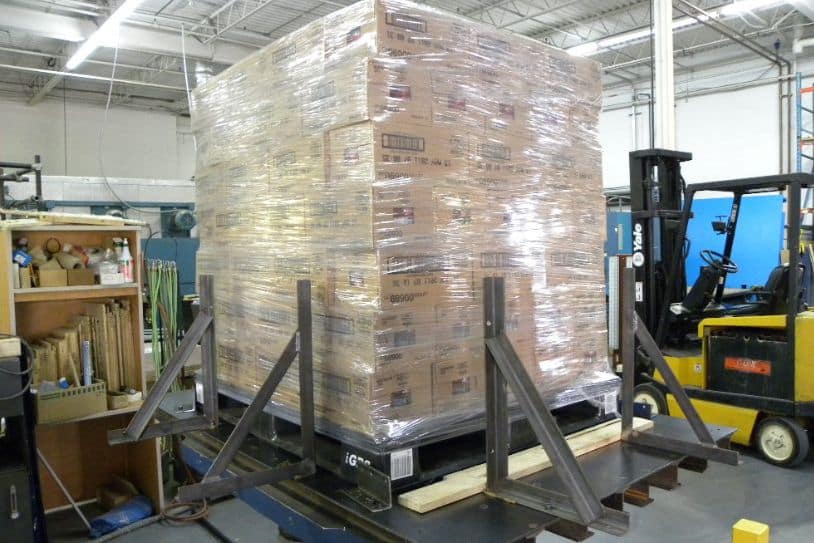
5 Reasons You Should Do Packaging Transport Tests
Quick Links
1.0 Why Is It Important to Do Packaging Transport Tests?
2.0 5 Reasons Why You Should Do a Packaging Test
3.0 7 Packaging Tests You Should Do
3.1 Random Vibration Test
3.2 Incline Impact Test
3.3 Drop Test
3.4 Compression Test
3.5 Accelerated Aging Test
3.6 Altitude Chamber Test
3.7 Mechanical Handling Test
4.0 Conclusion
Why Is It Important to Do Packaging Transport Tests?
Billions of dollars are spent annually on packaging in Canada. The globalization of markets, Asian imports, and online purchases are some of the phenomena that increase the number of protective packaging products used every day. As a result, products travel farther and farther and must therefore be better and better packaged to reach their destination in good condition.
At Micom Laboratories, we believe in the performance of your packaging. So for your customer to receive his product in perfect condition, it is crucial to do several transport and environmental tests. Our packaging tests are simple, fast and affordable. We measure quality according to industry standards and the different distribution methods used.
In this article, you will discover the five reasons why you should test your packaging. Afterward, we will explain the tests we do at Micom Laboratories.
The 5 Reasons Why You Should Do Packaging Tests
1. To Avoid Financial Losses
Inadequate quality in packaging takes different forms, the most obvious being the breaking of the product that the packaging was supposed to protect. However, the impact of this disruption on the recipient must be added to these immediate costs.
Imagine that your lean manufacturing is stopped due to damaged parts during transport. The piece may be worth only a few dollars. However, the financial impacts could be much greater than the value of the damaged parts themselves.
Your supplier makes amends and vastly improves its packaging. They confirm this by email by stating that the cost will increase by 10% per piece due to additional packaging costs. You decide to accept this increase. The next shipment arrives. Because of the difficulty in opening the individual packaging protecting the parts, your production has to manage three times more waste than before. Even worse, you had to add a person to the production line to keep the pace. Will you name this supplier “supplier of the month”?
2. To Ensure Client Satisfaction
Customer satisfaction is related to the fact that the product will arrive quickly and intact at its destination. Packaging is also intended to promote a product. A package may be environmentally friendly, but if the contents of the package arrive damaged, it is not a good package and it will reflect in terms of customer satisfaction and environmental impact.
Some statistics to prove it all:
- A European Community report produced in 1999 estimated the annual losses due to damage during distribution in Europe to be US $3 billion.
- The estimated annual global losses in distribution would be greater than US $100 billion.
It is vital to consider the degree of fragility of your products. The packaging must be resistant to shocks and vibrations of transport. The packaging must also be simple to unpack. If the product does not arrive intact, all your efforts regarding the creation and marketing of your product will be for nothing.
3. To Identify Weaknesses in Your Product Packaging and Correct Them
For each product, there is optimal packaging. How to reach it? We are talking about the line between underpackaging and overpackaging. For an underpackaged product, the damage-related costs increase. However, if your product is overpackaged, you’ll incur new raw material expenses that may be supplemented by the additional costs from your customers: handling, disposal, environmental impact, etc.
4. To Make Your Product More Environmentally Friendly
The environmental impacts of packaging products are well known around the world. In 2022, many countries were aware of this movement and created laws or regulations on plastic packaging.
In France, there is an anti-waste law to promote a circular economy to limit waste and preserve natural resources. It involves various measures that will extend to 2040. Notably, the law forces the end of the marketing of single-use plastic packaging by 2040.
“The Government of Canada is committed to ensuring that all plastic packaging in Canada is made of at least 50 % recycled content by 2030, and to meeting an ambitious 90 % recycling target, aligned with Quebec and European Union targets, for plastic beverage containers.”1
More than 35 countries have already taken action to ban certain single-use plastics, including the United Kingdom, France and Italy. Canada’s approach is aligned with other influential jurisdictions, such as the European Union.
This affects the food industry a lot but using packaging that is not green is not perceived well today. Also, if the product does not arrive intact, all these efforts are in vain.
5. To Have Peace of Mind
If you have doubts about the performance of your packaging, it is always best to do tests to prevent the risk of your product breaking during transport. These tests will give you peace of mind.
Temperature control
In the medical and pharmaceutical industries, it is imperative to do tests to ensure the preservation of products at specific temperatures. Storage conditions are often strict. For other sectors, it may be appropriate to perform packaging tests under different temperature and humidity conditions depending on the sensitivities of the product to ensure the quality of the final product once delivered to the client.
Protection against shocks
A product is often subject to long-distance transport, so we must ensure that the packaging will be effective against shocks and vibrations during transit. Different distribution methods will present very different challenges to your packaging. For example, when sending parcels by mail, you can assume that, on average, each package will be subjected to 17 falls of between 12 and 24 inches in different directions.
Do you have arrows on your boxes indicating the direction in which your package should be transported? In this business, these arrows are considered an indication of the direction in which the box should be launched.

7 Packaging Tests You Should Do
1. Random Vibration Test – ASTM D4728
If your product must make a long journey by road, air, and rail transport, it is strongly recommended to do random vibration tests for your packaging such as ASTM D4728. These tests make it possible to check the strength of the packaging when faced with specific constraints.
How do we do this test at Micom?
At Micom, we have a vibration table that can simulate distribution stress by applying vibration profiles ranging from 0 to 300 Hz and 1G. It is possible to perform vibration tests according to different standards.
The vibrations are applied randomly to the test load with frequencies and intensities typical of the distribution environment. This is done by using a servo-hydraulic system that is programmed to a power spectral density (PSD) simulating the vibration profile corresponding to the type of transport mode used.
The vibration profile depends on several factors, including the dimensions, weight, type of packaging and the distance of transport of your product. This technique allows us to reproduce the vibration profiles of the different types of suspension of the vehicle, whether it is a pneumatic suspension, a small delivery truck or an aircraft.
2. Incline Impact Test (Conbur) – ASTM D880
The ASTM D880 incline impact test is a packaging transport test included in several test standards, such as ISTA 1E. The incline impact device evaluates the strength of the packaging by giving horizontal impacts or by using the crushing force.
Real examples:
- A product is packed and placed in the back of a truck that stops abruptly.
- A pallet falls to the ground.
These tests are simple, but the results give us good indicators, especially for high-value or heavy products.
The following are examples of standards for packaging/transport testing that require incline impact testing:
There are 2 procedures for performing a shock test on containers:
- Procedure A tests the ability of a container or shipping unit to withstand impacts.
- Procedure B tests the capacity of a container or transport unit or inner packaging to protect the contents when subjected to impacts.
3. Drop Test – ASTM D5276
This ASTM D5276 test verifies the resistance to falls of packaged products and the resistance of the packaging itself during transport, loading, and unloading. Our package drop test ensures accuracy. It allows us to evaluate the consequences of possible falls when handling the product during transportation.
Products still being designed and finished items like furniture, suitcases, toys, etc., can be tested on an angle, on one side, on one edge or on a corner.
How is the test carried out?
The product is lifted at a precise height and then released. It is possible to perform fall tests for up to 2 m.
Free fall tests are carried out per ASTM D5276 and, like the inclined plane test, are required in several ISTA, ASTM and ISO standards.
4. Compression Tests – ASTM D642
ASTM D642 is a standard that determines the compressive strength of shipping containers (like boxes and barrels), components, and unit loads. The containers can be tested with or without contents. This test also determines the behaviour of the materials under load.
How is this test performed?
The package or sample is compressed and deformed, if necessary, with a compression device up to 9000 lbf.
5. Accelerated Aging
Accelerated aging is a type of test that amplifies normal conditions to assess the rate of aging of a material or product. These conditions can be environmental such as sun, heat, cold, salt water, etc. The objective of accelerated aging tests is to determine the lifespan or understand the reasons for the deterioration, discoloration and cracking of a product or material.
These controlled laboratory tests include:
6. Altitude Chamber – ASTM D6653
ASTM D6653 determines the effects of high altitudes on vacuum packaging systems. It is a method for testing a package to assess its resistance to low ambient pressure either in the mountains or in the baggage compartment of an aircraft.
The chamber used for the test must be large enough to contain the test sample under normal and depleted ambient pressure, but also big enough to allow for enlargement of the product, packaging, or both.
Typical experimental parameters for ASTM D6653:
- Number of samples: 3
- Sample conditioning: (5.6 ± 2) °C for at least 24 hours
- Expected altitude level: altitude required in specifications
- Vacuum duration: 1 hour
- Vacuum temperature: (5.6 ± 2) °C
- Relative humidity of packaging and test: ambient, unless otherwise stated
7. Mechanical Material Handling Test – ASTM D6055
The ASTM D6055 standard includes several test methods that will depend on the loads used. They make it possible to establish a qualitative correlation between the damage observed to the products or packaging during the test and the damage observed in the actual distribution. These test methods determine the effects of the pressure difference when your products are transported by air or at high altitudes.
Conclusion
For packaging that can hold up, choose Micom! Micom Laboratories follows the highest protocols in the market, such as ASTM, ISTA, SAE, and MIL-STD. We can determine which types of tests will be crucial for your products. Our laboratories are dedicated to transportation tests for packaging, and we can identify the different problems that could affect your sample (climactic, mechanical, etc.). These tests will make your different types of packaging more resistant.
For more information on our packaging tests, please visit our Package Testing and ASTM Package Testing pages. Do not hesitate to contact the Micom Laboratories team to schedule a complete review of your packaging or take an appointment for a quick consultation with our experts.


